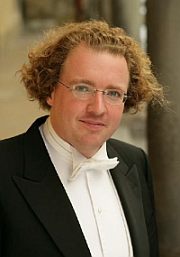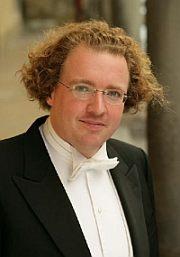
Photo by J. Henry Fair
On paper, the program — Debussy’s Iberia, Fauré’s Suite from Pélleas et Mélisande, Jennifer Higdon’s blue cathedral, and Mozart’s Piano Concerto No. 24 in C Minor, K. 491 — looked rather unremarkable: There were no surprises, no big symphonic works. Denève made all the difference. The conductor, who has been music director of the Royal Scottish National Orchestra since 2005, limned each work with vigor, refinement, and a keen facility for revealing the orchestra’s inner voices.
In Friday’s performance at Davies Symphony Hall, Denève, not surprisingly, made the strongest impression in the all-French second half. With his round spectacles and mop of curly hair, Denève looks a bit like Schubert, yet his podium style recalls the kind of exuberance Bay Area audiences recently witnessed from Gustavo Dudamel, large gestures and hair-tossing included. In stylistic terms, though, the conductor whom Denève most resembles is Charles Dutoit, a superb colorist for whom texture and transparency are paramount.
In the music of Denève’s countrymen, each work came across with uncommon beauty and clarity. He whipped up considerable fervor in Debussy’s Iberia, the swaggering showpiece from the composer’s Images pour Orchestre. Yet what I noted was the care with which he brought each section’s contributions to the fore — the boastful brass, the swaying cellos, the jaunty clarinets — and, shaping each with a masterful hand, integrated them in the larger sound world.
If Fauré’s suite sounded a tad pale in comparison, blame not the conductor or this orchestra. Denève let the performance blossom organically, lavishing attention on the smallest details. The string sound was delicate, beguiling; the famous flute solo of the “Sicilienne” movement, played with lithe, silvery tone by Timothy Day, was especially lovely. (Pairing these works, of course, amounts to a clever feat of musical logrolling; Fauré, who exerted a major influence on Debussy, undertook the incidental music for a London production of Maurice Maeterlinck’s play only after Debussy was offered the assignment and declined, believing that the play might be fertile material for an opera — and the rest, as they say, is history.)
Refined, Beautiful Playing
Denève also achieved radiant results with Higdon’s blue cathedral which opened the program. The Philadelphia-based composer, who wrote the piece in 1999 on commission for the 75th anniversary of the Curtis Institute of Music, has often been compared to Barber and Copland. But Denève drew inspiration for the work from his mastery of the program’s French music, making it seem a natural descendant of Fauré and Debussy. I’ve heard Higdon’s score in other settings, though never played with such beauty and refinement. The soft chiming of bells that opened Friday’s performance; the open intervals of the low strings that followed close behind; the interplay between flute, clarinet, and solo violin — all were gracefully articulated.In the middle section, the music grows denser, more active, but it’s in the final pages, rung to a close with the tolling sound of a prepared piano, that Higdon achieves a sense of timelessness. Denève conducted it like a benediction. These concerts represented the first S.F. Symphony performances of blue cathedral, and the conductor ushered it into the orchestra’s repertoire with admirable sensitivity.
In between, there was Mozart’s Piano Concerto No. 24, with Piotr Anderszewski as soloist. Under Denève’s direction, the Polish pianist gave a graceful, elegant performance. Neither the conductor nor his soloist tried to artificially brighten this essentially dark-hued work, though Anderszewski’s deft passagework in the outer movements was dazzling. Still, Mozart’s slow movement tells the tale. Chirping woodwinds and that insistent little tune for violins aside, the music is quietly somber, and Denève, always mindful of balances, applied painterly dabs of color to brilliant effect.

